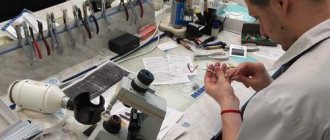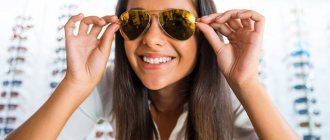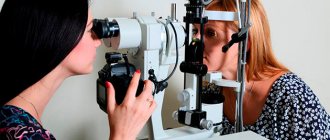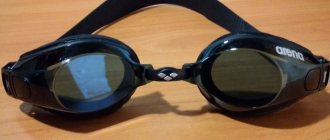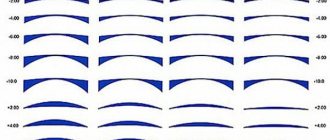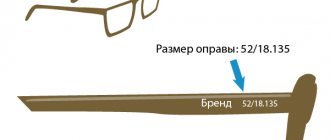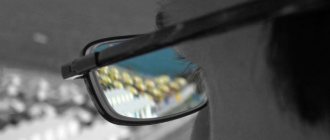We are all born farsighted: the eyeball of a newborn is somewhat short for the visual system of the cornea, lens and vitreous body that is formed in the eye at the beginning of childbirth. So, to the lack of training of the muscles that control focusing, there is added a shift of this focusing beyond the retina so that the image of closely located objects on it turns out to be blurry. Gradually, after a short time, the muscles that control the lens will learn to behave “correctly”, and the baby will begin to see the world clearly and clearly, and recognize in it the main object of this world - the mother.
But clarity of vision does not come to this norm immediately. If you look at the age-related changes in a person in terms of the proportionality of the parts of his body, you will notice that the ratio of the sizes of the head and eyes changes dramatically with age: by the age of 18-20, the head grows three times in size compared to that of an infant. By the same age, the eye will increase in size compared to an infant by only 40-50%. This is precisely the reason for the ban on radical eye surgery for people aged “18 minus” - the tissues have not yet formed.
Underfocus
Until the body is fully formed, the imbalance between the sizes of the parts of the skeleton (including the skull) is compensated by the ability of the eye tissues to make adjustments to the construction of the image on the retina. The focusing point is shifted and is located deep in the photosensitive layer, and not on its surface, and is this because the eyeball has not grown enough? The ciliary muscles of the lens will tense or relax a little more than normal, thus correcting the blurred vision.
The appearance of farsightedness, or hypermetropia, which does not go away on its own, worsens over time, or appears at an older age, is always associated with one or several reasons at once:
- A shortened eyeball with a shape close to a ball. Whereas during normal development it is somewhat elongated along the optical axis of the eye. Excessive elongation will, on the contrary, cause myopia, or myopia.
- Insufficient curvature of the cornea, causing its refractive power to be less than necessary. The result of this pathology is that the refractive indices of the cornea show less than the normal 43 diopters.
- The lens is set too deeply, due to which even the most relaxed ciliary muscles cannot ensure the proper curvature of the surfaces of this focusing organ, as a result of which its power in diopters is not enough to focus the image on the surface of the retina
- Incorrect functioning of the ciliary muscle, causing the inability of the lens to correctly change its curvature
- Spasm of accommodation. Most often occurs in childhood
Of the listed deviations that cause farsightedness, only the one indicated by point 4 will cause this vision defect in old age. This affects the fatigue of the muscles that work all their lives to stretch or contract the lens - the protein tissue of which also gets tired, loses its flexibility and ability to quickly rearrange itself depending on the distance at which the object in question is located. And the more intense the work of the eyes during a person’s life, the faster fatigue sets in, provoking the appearance of hypermetropia. Or, in relation to old age, this disease is more often called presbyopia.
Construction of an image for farsightedness
People unfamiliar with the subject have a stereotype that with farsightedness a person sees poorly only up close, but such a person is fine with the clarity of distant objects. But the trouble with hypermetropia lies in the fact that a person sees distant objects poorly, distinguishing only the general contours of objects. And without corrective devices in the form of glasses with “plus” lenses or contact lenses that increase the curvature of the cornea, it is impossible to achieve vision close to normal
Unlike farsightedness, myopia, or nearsightedness, causes inconvenience only when viewing distant objects. With vision of minus 2-4 diopters, glasses or lenses for reading are not required at all - the required 30-35 centimeters to the page of the book is not an obstacle to distinguishing text.
An eye pathology such as hyperopia, no matter what it is caused by, thus causes much more inconvenience than myopia. And glasses for constant wear are also not able to fully compensate for the shortcomings of focusing the image on the retina. After all, if a positive or “plus” converging lens easily corrects the path of light rays falling on the retina from objects located in the distance, then to view objects that are nearby will require either extreme tension in the muscles that control the operation of the lens, or the use of other glasses, with other refractive indices. And by the way, this is what most people with farsightedness do: they have a second pair of glasses to work with objects that are close. Which is both expensive and inconvenient.
Bifocal and trifocal lenses
The solution is to order bifocal glasses, where the upper part of the lens works for distance, and the lower part is designed for reading or manipulating small objects, which the naked eye cannot handle. But bifocal glasses, naturally, are more expensive than regular glasses - already quite expensive - ophthalmology in this regard, in terms of the price of services, is increasingly approaching dentistry: go to any optical store? There, even non-branded frames cost between 2-3 thousand rubles. It is better to remain modestly silent about the price of frames from well-known companies. But in addition to rights, we also need lenses, which can have a very complex structure, with the introduction of anti-reflective, polarizing, hydrophobic and stain-resistant, protecting from UV rays and hardening layers.
Trifocal lenses cost even more than bifocals for viewing objects up close, at medium distances, and in the distance. A compromise was the development and appearance of glasses for farsighted people with the technology of manufacturing so-called “progressive” lenses, in which the power in positive diopters increases from the bottom of the lens to its top. This corresponds to the distribution of diopters in bifocal and trifocal glasses, but not stepwise, as in them, but smoothly - you just need to get used to holding your head in the correct position in order to use this or that section of the lenses of these glasses correctly.
Factors that influence the selection of glasses
To choose the right glasses for hypermetropia, the ophthalmologist must consider the following factors:
- Professional activity;
- Hobbies and interests;
- Presence of concomitant diseases;
- Age category. This is due to the fact that children's optics for farsightedness are different from adult glasses;
- Degree of hypermetropia.
When a patient cannot see only at close range, there is no point in choosing glasses for constant wear. It is recommended to wear optics only when necessary (when reading, writing, working at a computer monitor, etc.). If the patient has concomitant pathologies (myopia, astigmatism and others), glasses are selected for constant wear.
Degrees of farsightedness
As with myopia, there are three degrees of farsightedness.
- Up to “plus” 3 diopters, or weak degree.
- From “plus” 3 to “plus” 6 diopters – average.
- More than “plus” 6 dioptres is a high degree.
The presence and extent of the disease are most often detected, especially in the initial stages, only in the ophthalmologist’s office. But there is a sign that unmistakably indicates that “the process has begun” and timely help is required. These are frequent, seemingly unmotivated headaches and a burning sensation in the eyes, which usually begins at the end of work or in the evening at home.
In the initial stages of farsightedness, with “plus” to “one”, the ciliary muscle, which controls the operation of the lens, still copes with the precise focusing of light rays reflected from the object in question. But this is just “for now” - such precise focusing requires excessive effort, which in the future leads to the rapid progression of the disease.
The choice of glasses (and frames for them) will be made with the cooperation of three parties: the ophthalmologist, the patient himself and the employees of the optical salon, taking into account his profession, his work schedule, lifestyle, habits and possible concomitant diseases. This may be astigmatism - which will complicate the selection of lenses, increasing the complexity of making glasses.
In the initial stages of farsightedness, neither bifocal nor trifocal lenses are required; the need for them appears either with age, or simply as vision deteriorates and the number of required diopters increases.
The final word in choosing the type of lenses belongs to the doctor. It is he who can tell you exactly which lenses make sense to insert into the frame: bi- or trifocal or progressive. Then a specialist in the salon will get involved in the selection work. Therefore, such a criterion as the design or aesthetic component of the frame is not as important as functionality.
Correct selection
Glasses are prescribed when there is no other way to correct vision. The selection of points is carried out as follows:
- The patient must make an appointment and come to see an ophthalmologist.
- The specialist sits the patient at a distance of six meters from a special table for testing vision.
- First of all, the ophthalmologist checks visual acuity.
- Next, it reveals the degree of hyperopia or presbyopia (age-related farsightedness). To do this, a trial lens is applied to each visual organ. The selection begins with the thinnest optics, which are gradually thickened. A correctly selected option does not cause discomfort and restores image clarity at short distances.
- If necessary, the specialist prescribes additional vision examination measures.
- With a high degree of hypermetropia, the ophthalmologist prescribes optics from +6 diopters. With an average degree of farsightedness from +3 to +6 diopters. When weak, up to +3 or less.
Click to enlarge:
Contact lenses as an alternative
Those who decide to acquire contact lenses that correct hypermetropia face even greater problems - it is not without reason that they became more or less widespread only 20 years ago, with the advent of appropriate technologies. After all, the manufacture of such lenses makes sense only when they are made to order, using the technology of “progressive” lenses and using the same technique as in the case of contact lenses for astigmatism: a certain segment is removed from the lenses, which will not allow them to rotate on the cornea around its optical axis and not cause a malfunction when viewing close or distant objects. But individual manufacturing also implies a higher price - which is hardly attractive to those same pensioners. Refusal to wear corrective contact lenses often stems from the inherent conservatism of many older people. Glasses are more convenient and familiar to them.
Before returning to the main topic - “Glasses for farsightedness”, we should briefly dwell on the types of contact lenses designed to correct such a vision defect:
- Bifocal, or variable. With upper and lower optical zones, for viewing objects far and near, with a sharp transition between them and the absence of a middle zone.
- Multifocal - with the presence of a third, middle zone. Their disadvantage is the same as in the case of using glasses with trifocal lenses: when trying to look at objects from the side, squinting your eyes will do nothing; you need to either tilt your head to the side or turn completely towards the object of consideration.
- Spherical. Only for elderly people leading a quiet lifestyle. Categorically not suitable for driving vehicles where bifocal vision is required.
- Aspherical, they are also progressive. The only drawback is the very high price.
- Concentric, or circular, are a modification of bi- and trifocal lenses. They represent an alternation of 4-5 concentric circles with different degrees of refraction in one lens.
Requirements for distance glasses
Often the complexity of making lenses inherent in glasses for farsightedness (and, by the way, their greater massiveness compared to lenses for myopia) requires greater strength and rigidity of the structure. True, frame manufacturers do not focus the attention of consumers on this, but any more or less competent (and conscientious) employee of an optical salon will definitely point out this aspect to the buyer. After all, the frame that can easily hold a myopia lens that is lighter in weight may not be able to withstand the weight of a more massive “plus lens.”
After all, what does a negative lens look like? The glass is thick at the edges and very thin in the center, resulting in a convex-concave surface, where the concavity prevails over the convexity.
In the case of lenses for farsightedness, the picture is the opposite: on the convex-concave surfaces of such a lens, the center is thicker and more massive than the edges. But glass is a very heavy material!
Therefore, frames for glasses with positive lenses must be selected with strong screws securing the glass, or, in the case of solid “horn” frames, with a good temperature resistance coefficient - so that, even when softening in extreme heat, such frames retain the ability to hold glass.
This is only one requirement for such frames, in addition to the aesthetic component. But, in addition to strength and design, you need to consider:
- Fixing the temples of glasses behind the ears. The ends of the arms should not put pressure on either the ears or the area of skin on the head behind them. In such cases, it is best to involve an optical salon employee to select frames, who will help to visually determine such a parameter; the skew or incorrect direction of the end of the arch is clearly visible to the naked eye.
- The best distance between lenses is 12 mm.
- The tightness of the fit of the nose pads of the frame to the bridge of the nose: it should not be excessive and put pressure on the nose, leaving marks on it in the form of redness and dents. The best nose pads in this regard are made of soft silicone, inherent in glasses with metal frames and spring flexes (hinges or hinges) connecting the frame and temple of the glasses.
How to choose glasses for farsightedness
Profession
There are professions with specific conditions for vision. An example is professional musicians, for whom, when playing in orchestras and under the direction of a conductor, the distance from their eyes to music stands is about a meter (plus or minus 10-15 cm).
Anatomical features of the face
In the case of deep-set eyes, it is sometimes better to use contact lenses instead of glasses: if the distance from the cornea but the lens of the glasses is more than 12 mm, a person’s vision will have strong parallax and perspective distortions.
Age
With some of these changes, glasses with weaker diopters than necessary are prescribed (usually by 0.5 - 1.0 degrees).
When working with small parts
In such patients, it is recommended to install LED backlighting on glasses.
In addition to those listed, some criteria for selecting glasses, after diagnostic measures such as ultrasound and biometric studies, can be advised by an ophthalmologist.
The presence of a pathology such as farsightedness requires even more careful monitoring of eye health than with myopia. Passing medical examinations at least once a year is mandatory! And if changes have occurred over the past year (no matter - for the better or for the worse), a mandatory correction in the parameters of glasses or lenses will be required. Ignoring this requirement can lead to a sharp deterioration in vision.
Is it possible to cure farsightedness in a child? Causes of development and methods of treatment
15.08.2018
Farsightedness in children 2, 3 and 5 years of age does not appear spontaneously; most often there is a congenital pathology.
There are several degrees of development of the disease: weak, medium and high.
- When the disease is mild, the child sees objects clearly, but prolonged use of the eye muscles leads to headaches and dizziness.
- In the middle stage of development of farsightedness, the child sees well at a distance, but up close the outlines seem blurry and indistinct to him.
- When the disease progresses to a higher degree, the child sees equally poorly near and at a distance.
What causes farsightedness?
- Anatomical pathologies (insufficient degree of curvature of the cornea, incorrect location of the lens).
- Presence of glaucoma.
- Heredity.
- Pathologies of pregnancy.
For complete information about the causes of farsightedness, see this article.
How to determine that a child suffers from farsightedness?
- While looking at the pictures, the child holds the book with outstretched arms.
- The child is reluctant to read regular books, preferring to study signs and posters with large inscriptions.
- The child has a low reading speed.
These are not all signs of possible vision problems; at the slightest suspicion, you should immediately visit an ophthalmologist.
If your child has already been diagnosed with farsightedness, you need to start treatment (the course depends on the age of the child and the degree of the disease).
How does childhood farsightedness develop?
Depending on the age of the child, doctors have different attitudes towards this pathology:
Farsightedness in a 2-3 year old child. You always need to understand that while a child is under 3 years old, his visual organs are constantly developing.
It is very important to detect existing deviations directly in this time interval in order to begin treatment in a timely manner and not lose the chance of normalizing visual functions.
At this age, radical treatment is usually not prescribed; most often, by the age of four, all symptoms of farsightedness disappear.
Farsightedness in children 5-6 years old. As a rule, the problem is discovered during this period due to the baby’s inability to indicate discomfort earlier.
One can only indirectly suspect something is wrong - with visual stress, the child soon gets tired and irritated, and a state of nervousness arises.
Also at this time, children begin to attend school, the load only increases, and there is a risk of intensive development of pathology.
Farsightedness in a child 7-10 years old. Normally, in children over 10 years of age, as a result of treatment, vision should already be normalized. If it is not possible to reduce the development of farsightedness, you need to take the necessary measures. Such children are prescribed to wear glasses (sometimes contact lenses).
What is a small margin of farsightedness?
There is a condition when farsightedness is below normal (observed in children no older than 6 years). This is due to the rapid growth of the eyeball. When diagnosing this phenomenon, doctors talk about a small reserve of farsightedness in a child.
The appearance of such symptoms is undesirable, as it can provoke the development of myopia. If the diagnosis is confirmed, treatment is prescribed to the child to restore normal parameters.
Treatment of farsightedness in children
To treat farsightedness, doctors recommend training the visual organs with some alternating loads on one and the other eye.
Experts predict a positive effect when treated in the following ways:
- Alternate drawing and reading classes.
- Stimulation of motor function. The most important stage of therapy. Sufficiently oxygenated blood ensures the necessary tissue metabolism in organs, ensuring their development.
- Taking additional medications that accelerate tissue metabolic processes. However, such drugs are often dietary supplements, and not medicines at all, so you should not rely only on their effect.
- Microsurgery. For children under three years old, such interventions are contraindicated, since during this period the visual organs are actively developing.
- Laser therapy. Specialists resort to laser surgery only after the patient reaches 18 years of age.
- Sessions of vacuum massage and electrical stimulation.
- Auto-trainings.
Should my child wear glasses?
The vision of children under 3 years of age with farsightedness, as a rule, does not need correction. At such an early age, wearing contact lenses or glasses is even dangerous. The disease can go away on its own over time, so many experts say that weak farsightedness in children is normal, and glasses will only get in the way.
But there are also exceptions, when the disease manifests itself too strongly already in the early stages of a person’s age-related development, and the pathology reaches a high degree.
Older children, if necessary, are prescribed to wear glasses, provided that the doctor is solely responsible for their choice - more information about the choice of glasses is written here. Replacing glasses with contact lenses is only possible for teenagers who are able to use them correctly.
Vitamin therapy
Parents should give vitamins for farsightedness in their child, preferably in natural form. It is necessary to provide the children's diet with useful microelements and vitamins, so the child's menu should be enriched with:
- Peaches and bananas.
- Apricots and prunes.
- Walnuts, raisins and dried apricots.
- Cabbage, carrots, tomatoes and peas.
These foods are rich in potassium. It is necessary to consume vitamins C and A (found in rose hips, citrus fruits, and zucchini). Wild blueberries are very beneficial for eye health; taking them helps improve vision and reduce fatigue.
Surgical methods for correcting hypermetropia
This method, due to its simplicity and accessibility, is very popular - but only in the absence of contraindications and after reaching the age of 18 years. The essence of the operation is that the periphery of the cornea is exposed to a needle heated to a strictly calculated temperature. Or such an effect is performed by a laser beam (laser coagulation). As a result, the cornea is pulled towards the central zone of the eyes, approximately at the level of the pupil, thereby increasing its curvature, and therefore its refractive power in diopters.
In addition to laser coagulation, another method of exposure to concentrated coherent radiation is used, called laser keratomileusis. In it, an increase in the curvature of the cornea is carried out due to the “cold evaporation” of cells under the influence of short-term pulses of an excimer laser.
All these operations are non-cavitary, eliminating injury to the eye. They rarely last more than 2 hours and in terms of postoperative care they have no equal.

